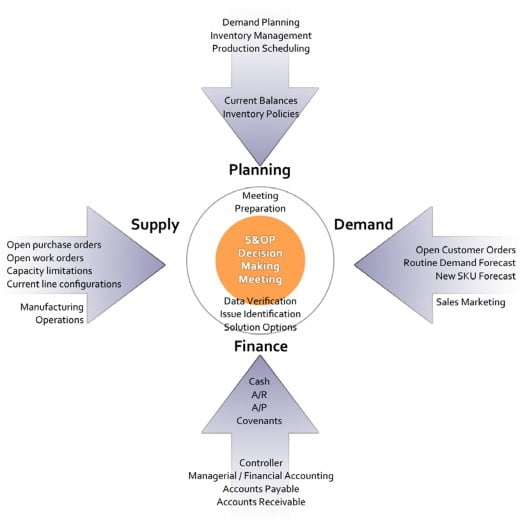Manage Collaboration Across the Entire Organization
Ralph Cox
Principal, Tompkins International
www.tompkinsinc.com
Thomas Wiedmann
Managing Director, Tompkins International
www.tompkinsinc.com
February 2012
Introduction
Sales and operations planning (S&OP) brings supply chain management as close to real-time as possible while ensuring alignment with the execution of overall business strategy.
In the late 1980s, S&OP originated in manufacturing where, as opposed to distribution or retailing, the need for such a process is most obvious due to the physical proximity of the interested parties. The process has since evolved a great deal. Today, definitions of S&OP and its applications to associated business processes vary wildly.
S&OP Definitions Vary:
From the conceptual: “Aligning business goals with supply chain tactics.” 1
To the day-to-day operations: “The function of setting the overall level of manufacturing output (production plan) and other activities to best satisfy the current planned level of sales (sales plan) while meeting general business objectives of profitability, productivity, competitive customer lead times, etc. as expressed in the overall business plan.” 2
To the very broad: “… a process to create a single consensus operational and financial plan for the firm through a series of coordinated reviews led by senior management to integrate strategic, operational and financial plans over an extended horizon.” 3
To the very narrow: A structured process to reconcile conflicts between demand, supply and inventory priorities created by unplanned variability of any type.
All of these definitions are valid. The diversity is consistent with S&OP’s ongoing evolution from casual to formal; tactical to strategic; and lower to higher levels of the product hierarchy. S&OP’s ongoing evolution is also changing from operational and managerial levels to executive levels; and from being just internal to both internal and external.
All S&OP processes, however, are meant to help business leaders make better demand and supply coordination decisions. In most cases, these informed decisions would otherwise be impossible.
This paper outlines the case for S&OP, its benefits, the importance of collaboration between various organizational levels, and the implementation process for S&OP.
1 Aberdeen Group, Sales and Operations Planning: Aligning Business Goals with Supply Chain Tactics. http://www.aberdeen.com/Aberdeen-Library/4905/RA-sales-operations-planning.aspx
2 John R. Dougherty, Getting Started with Sales and Operations Planning, APICS Master Planning of Resources Reprints, 2000, p. 24.
3 Voluntary Interindustry Commerce Solutions, “Linking CPFR and S&OP: A Roadmap to Integrated Business Planning,” September 2010. http://www.vics.org/docs/committees/cpfr/CPFR_SOP_Guideline_Ver1.0Sep2010.pdf
1.0 The Need for S&OP
The answer to whether or not S&OP is needed becomes clear to all concerned when demand is incompletely addressed, cost-compromised or inaccurately addressed, when inventory relocations are common and when write-off is necessary.
1.1 A Simplistic Example
Take the example of a sales department which closed the first sale to a new customer and committed to ship a quantity of Product A by a certain date to demonstrate responsiveness. However, sales is not aware that the inventory of Product A has been committed to customer orders received earlier, and Product A is not yet scheduled for additional production.
Meanwhile, manufacturing is running Product B and planning has scheduled a run of Product C next.
All the while, the finance department has cash projected based on the shipments of Products A from inventory and B and C from production.
In this example, there are no good outcomes. The compelling reasons for S&OP become all too clear in such situations.

1.2 Applying S&OP
Why does S&OP help any manufacturer? For a smaller firm in a central location, or a larger firm with operations in many different locations or countries, S&OP will be beneficial.
For any firm, issue reconciliation via hallway conversations, sticky notes and emails between some – but not all – of the
stakeholders is ineffective. Such a casual approach many catch some issues, but it cannot catch all of them, and the firm suffers when demand is not met, shipments must be expedited, inventory must be repositioned and overstock must be liquidated.
Demand-supply issues are potentially catastrophic. What is missing is a process-driven, collaborative information flow to ensure that the strategic targets of the company are not compromised.
Consider the following real-world examples, the organizational level at which the issue initially surfaced, and the undesirable outcome:
-
The Executive Level:
-
Significantly increased inventory requirements in support of upcoming promotion; demand not visible to finance ahead of time leading to subsequent cash issues.
-
Changes in product availability not visible to sales when delivery commitments were made with subsequent customer frustration.
-
Unanticipated manufacturing capacity issues due to differences in raw material specifications stemming from sourcing changes.
-
-
The Management Level:
-
SKU discontinuation decisions developed between some, but not all, stakeholders which were subsequently rescinded.
-
Future demand in excess of capacity not visible to planning or manufacturing ahead of time.
-
Unanticipated lengthening of supplier lead times requiring significant re-work of production and labor schedules.
-
-
Operations Level:
-
Less-than-complete bills of material and non-existent artwork for new SKUs recognized too late to address other than with air freight.
-
Changes in product configuration not communicated from engineering department to the planning, manufacturing, or sales areas, resulting in back-to-school product only becoming available in October.
-
Receipt from a non-validated supplier of an off-specification product with a very limited worldwide supply base.
-
In the more than 20 years since the sales and operations planning concept was developed, businesses, information systems and outsourcing economics have evolved tremendously. Now, manufacturing can take on a variety of styles, such as historic in-house, historic sub-contract, mixed, virtual, or private label, as defined below (Figure 1).
|
Style |
Ownership |
Execution |
|||||
|
Brand |
3-D Product Design or Concept |
2-D Product Details or Recipe |
Tooling |
Equipment and Process Technology |
Raw Materials |
Labor |
|
|
Historic In-house |
OWNER |
OWNER |
OWNER |
OWNER |
OWNER |
OWNER |
OWNER |
|
Historic Sub-contract |
OWNER |
OWNER |
OWNER |
OWNER |
CONTRACTOR |
EITHER |
CONTRACTOR |
|
OWNER |
OWNER |
OWNER |
CONTRACTOR |
CONTRACTOR |
EITHER |
CONTRACTOR |
|
|
Mixed |
OWNER |
OWNER |
CONTRACTOR |
CONTRACTOR |
CONTRACTOR |
EITHER |
CONTRACTOR |
|
Virtual |
OWNER |
CONTRACTOR |
CONTRACTOR |
CONTRACTOR |
CONTRACTOR |
CONTRACTOR |
CONTRACTOR |
|
Private Label |
ANOTHER OWNER |
OWNER |
OWNER |
OWNER |
OWNER |
OWNER |
OWNER |
Figure 1. Ownership and Execution of Various Modern Manufacturing Styles
As outsourcing of manufacturing processes becomes more common, the need for S&OP increases exponentially because of increased lead times, distances, and the number of organizational entities and languages. Using multiple sub-contractors which ship semi-finished product to one another in a sequential manner just exacerbates the need further.
S&OP is becoming an essential business process across manufacturing styles of all types. Further, the benefits of S&OP are being recognized and applied in distribution and retailing. In the future, S&OP will likely evolve to become the foundational supply chain planning process and, for some firms, the foundational management process.
2.0 The Benefits of Establishing S&OP
Most purchasers of manufactured products primarily base purchasing decisions primarily on quality, customer service and cost; and secondarily, on reliability of supply, environmental responsibility, product innovation, and other factors. Robust S&OP processes drive improvements in customer service, cost, and reliability of supply in both the short- and long- term.
Working in a sound manner, they bring information up-to-date on current and anticipated customer demand with anticipated supply so that modifications, if any, can be identified and implemented proactively. S&OP processes also increase visibility and maximize the likelihood that the efforts of all parts of the organization are coordinated.
As S&OP business processes mature, the benefits both increase and evolve as below:
-
Initial efforts
-
Reduce forecast error
-
Improve demand planning and use of capacity
-
Improve communications and reduce miscommunications
-
-
Advanced efforts
-
Optimize inventory
-
Increase percent of A/P vs. “owned” inventory
-
Decrease cash-to-cash cycle
-
Improve order fill rates and on-time shipments
-
Improve coordination of new SKU launches
-
Improve production schedule adherence
-
-
Maturing efforts
-
Increase revenue, gross margin and profits
-
Increase productivity
-
Increase perfect orders
-
Year-over-year gross profit margin increases
-
While there may be legitimate differences of opinion on priorities, there is no real argument against collaboration to achieve any of the possible benefits.
3.0 The Business Process
At one or more organizational levels, the S&OP business process culminates in a meeting which yields actionable decisions for execution of supply chain operations at their maximum effectiveness. The best practice in most firms is to address this at multiple levels – usually the executive, management and operations levels – each working at an appropriate level in the product and logistics hierarchies.
The leaders at these different levels vary in their roles; for example, the executive level is proactive, while the operations level is reactive. The managerial level is a mix of both.
Understanding each organizational level’s role will foster better collaboration in the S&OP process. More of these differences in focuses and roles are outlined in the chart below (Figure 2):

Figure 2. Sales and Operations Planning Levels
The types of decisions also vary depending on the management level and the nature of the supply chain. The following examples of decisions are indicative of the range:
-
Executive Level Decisions
-
Re-shaping demand to match supply by modifying pricing, promotions, advertizing or specific customer agreements
-
Liquidating inventory
-
-
Management Level Decisions
-
Changing plant product production capacities through shift changes or equipment acquisition
-
Moving planned production between plants
-
-
Operations Level Decisions
-
Modifying open purchase orders or manufacturing work orders
-
Expediting, de-expediting and / or changing inbound transportation modes
-
The entities at each level, the type of information needed and the general nature of the process are illustrated by the following (Figure 3):

Figure 3. S&OP Process Mapped by Operational Level
The key to the process is the work completed prior to the decision meeting, In an ideal application, both data verification and data analysis, supported by technology, would be completed before any decisions are made. This includes:
-
Data Verification
-
Demand (forecast and excess open customer orders)
-
Supply (open and planned orders)
-
Capacity
-
Pro-forma inventory projection
-
-
Analysis
-
Identification of issues and opportunities
-
Identification of possible solutions and actions
-
A crucial aspect of the S&OP process is to ensure that the decision-making meetings are held on schedule with all participants present and prepared. The kind of business, and especially the SKU evolution rate, should determine the rate of how often meetings are held.
S&OP data verification, analysis, discussion and decision-making are necessary at the level in the product hierarchy which is the most meaningful – normally well above the SKU level; however, not so high as to be meaningless for decision-making.
Information technology can be a facilitator of data management, but is not a requirement for execution of the process.
4.0 Implementation Stages
Gartner4 accurately identified four stages in the development of S&OP processes:
-
Reacting, in which initial efforts are unbalanced, of minimum effectiveness, and the goals and benefits are questioned.
-
Anticipating, in which the process is textbook, as opposed to tailored, and the primary thrust is to treat the forecast as a given and match supply to it.
-
Collaborating, in which all participants begin to fully participate and “what-if” questions can begin to be successfully addressed.
-
Orchestrating, in which all of the demand and supply aspects can be fully exploited and, with the support of executives and finance, S&OP becomes the primary tool for managing the business.
The full support of management is required to accomplish the transition, especially in organizations in which the required participants are not accustomed to working together.
Management support is necessary because implementing an S&OP process requires significant cultural change for most organizations. The phrase “transformation from traditional” is apt.
Supportive change management processes, along with possible organizational re-alignment, workflow modification, and business process revision may all be required.
5.0 Conclusion
The benefits of S&OP are widely recognized. However, achieving optimal results is difficult largely because of the nature of the organization’s past management decision-making processes.
In an enlightened, flexible organization, the formula for success would involve a balance of approximately 50% process, 30% change management and 20% technology. For others, the balance may need to be quite different. Change management is a large part of any implementation effort. Change will come slowly, and a strong, unified vision is essential. However, as demonstrated by the success of others, the effort can be very rewarding.
4 Martin R, GMA and AMR Research, “The Demand Driven Supply Network DDSN, Your Business Operating Strategy,” 2006.
Contact Information
Tompkins International
info@tompkinsinc.com
About Tompkins International
Tompkins International transforms supply chains to help create value for all organizations. For more than 35 years, Tompkins has provided end-to-end solutions on a global scale, helping clients align business and supply chain strategies through operations planning, design and implementation. The company delivers leading-edge business and supply chain solutions by optimizing the Mega Processes of PLAN-BUY-MAKE-MOVE-STORE-SELL. Tompkins supports clients in achieving profitable growth in all areas of global supply chain and market growth strategy, organization, operations, process improvement, technology implementation, material handling integration, and benchmarking and best practices. Headquartered in Raleigh, NC, USA, Tompkins has offices throughout North America and in Europe and Asia. For more information, visit www.tompkinsinc.com.


